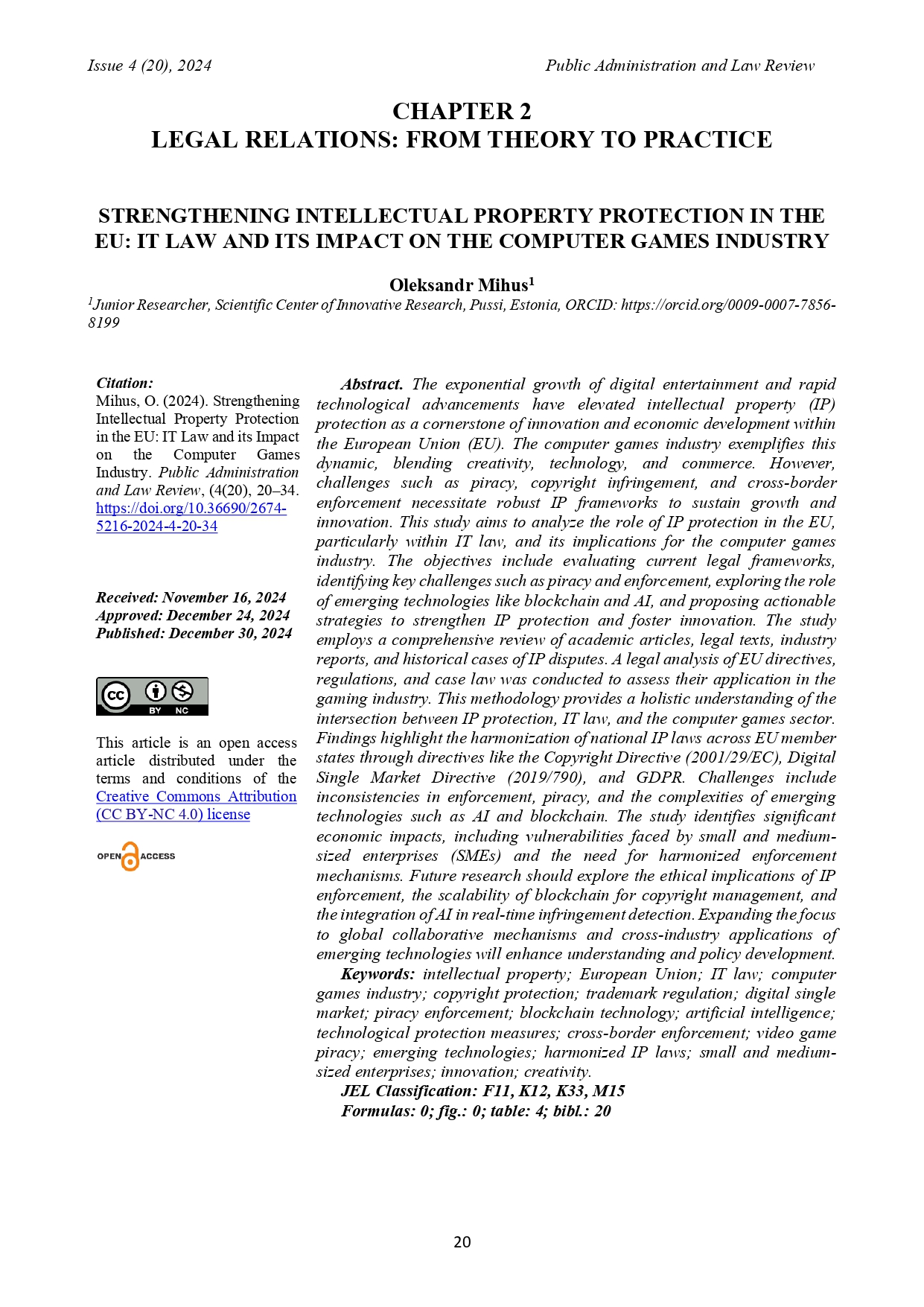STRENGTHENING INTELLECTUAL PROPERTY PROTECTION IN THE EU: IT LAW AND ITS IMPACT ON THE COMPUTER GAMES INDUSTRY
DOI:
https://doi.org/10.36690/2674-5216-2024-4-20-34Keywords:
intellectual property, European Union, IT law, computer games industry, copyright protection, trademark regulation, digital single market, piracy enforcement, blockchain technology, artificial intelligence, technological protection measures, cross-border enforcement, video game piracy, emerging technologies, harmonized IP laws, small and medium-sized enterprises, innovation, creativityAbstract
The exponential growth of digital entertainment and rapid technological advancements have elevated intellectual property (IP) protection as a cornerstone of innovation and economic development within the European Union (EU). The computer games industry exemplifies this dynamic, blending creativity, technology, and commerce. However, challenges such as piracy, copyright infringement, and cross-border enforcement necessitate robust IP frameworks to sustain growth and innovation. This study aims to analyze the role of IP protection in the EU, particularly within IT law, and its implications for the computer games industry. The objectives include evaluating current legal frameworks, identifying key challenges such as piracy and enforcement, exploring the role of emerging technologies like blockchain and AI, and proposing actionable strategies to strengthen IP protection and foster innovation. The study employs a comprehensive review of academic articles, legal texts, industry reports, and historical cases of IP disputes. A legal analysis of EU directives, regulations, and case law was conducted to assess their application in the gaming industry. This methodology provides a holistic understanding of the intersection between IP protection, IT law, and the computer games sector. Findings highlight the harmonization of national IP laws across EU member states through directives like the Copyright Directive (2001/29/EC), Digital Single Market Directive (2019/790), and GDPR. Challenges include inconsistencies in enforcement, piracy, and the complexities of emerging technologies such as AI and blockchain. The study identifies significant economic impacts, including vulnerabilities faced by small and medium-sized enterprises (SMEs) and the need for harmonized enforcement mechanisms. Future research should explore the ethical implications of IP enforcement, the scalability of blockchain for copyright management, and the integration of AI in real-time infringement detection. Expanding the focus to global collaborative mechanisms and cross-industry applications of emerging technologies will enhance understanding and policy development.
Downloads
References
Boni, G. (2021). Legal Regulation of Online Games in China: Master's Degree Thesis. Available at: http://hdl.handle.net/10579/19370.
Charles R. McManis, (1996). Taking Trips on the Information Superhighway: International Intellectual Property Protection and Emerging Computer Technology, 41 Vill. L. Rev. 207. Available at: https://digitalcommons.law.villanova.edu/vlr/vol41/iss1/5
Deere Birkbeck, Carolyn, TRIPS Implementation in Francophone Africa (December 2008). THE IMPLANTATION GAME: THE TRIPS AGREEMENT AND THE GLOBAL POLITICS OF INTELLECTUAL PROPERTY REFORM IN DEVELOPING COUNTRIES, Carolyn L. Deere, Oxford University Press, 2008, Available at SSRN: https://ssrn.com/abstract=1405228
Deng, Z., Chen, Z. Balancing Creative Expression and Societal Well-being: A Comprehensive Regulatory Framework for the Chinese Video Game Industry. J Knowl Econ 15, 10384–10411 (2024). Available at: https://doi.org/10.1007/s13132-023-01491-7
Dimita, G. (2023). WIPO Committee on Development and Intellectual Property. Available at: https://www.wipo.int/export/sites/www/cooperation/en/docs/ip-video-games.pdf
European Games Developers Federation (EGDF). URL: https://www.egdf.eu
Gervais, Daniel J., Intellectual Property, Trade & Development: The State of Play. Fordham Law Review, Vol. 74, pp. 505-535, 2005, Available at SSRN: https://ssrn.com/abstract=870065
Gibson, Christopher S., Globalization and the Technology Standards Game: Balancing Concerns of Protectionism and Intellectual Property in International Standards. Berkeley Technology Law Journal, Vol. 22, p. 1401, Suffolk University Law School Legal Studies Research Paper No. 07-39, Available at SSRN: https://ssrn.com/abstract=1010125
Handke, Christian, Intellectual Property in Creative Industries: The Economic Perspective (December 28, 2016). Forthcoming in: Waelde, C. & Brown, A. (eds.). Research Handbook on Intellectual Property and Creative Industries. Cheltenham: Elgar., Available at SSRN: http://dx.doi.org/10.2139/ssrn.2893066
Hargreaves, I. (2011). Digital Opportunity: A Review of Intellectual Property and Growth. Available at: https://infojustice.org/wp-content/uploads/2011/06/hargreaves-finalreport.pdf
Hubanov, O., et al. (2021). International legal regulation of copyright and related rights protection in the digital environment: Monograph. Available at: https://ojs.ual.es/ojs/index.php/eea/article/view/5014
International Intellectual Property Alliance (IIPA). URL: https://www.iipa.org
Jain, S. C. (1996). Problems in International Protection of Intellectual Property Rights. Journal of International Marketing, 4(1), 9-32. Available at: https://doi.org/10.1177/1069031X9600400103
Kenneth C. Shadlen, Andrew Schrank, Marcus J. Kurtz, The Political Economy of Intellectual Property Protection: The Case of Software, International Studies Quarterly, Volume 49, Issue 1, March 2005, Pages 45–71, Available at: https://doi.org/10.1111/j.0020-8833.2005.00334.x
Kovacic, W. E. i Reindl, AP (2004). An Interdisciplinary Approach to Improving Competition Policy and Intellectual Property Policy. Fordham International Law Journal, 28(4). Available at: https://ir.lawnet.fordham.edu/ilj/vol28/iss4/7/
Lisenco, V. (2021). Improving Competitive Strategies for the Protection of Intellectual Property. Eastern European Journal of Regional Studies. Volume 7. Issue 1. DOI: https://doi.org/10.53486/2537-6179.7-1.09
Marchenko, V., Dombrovska, A., & Prodaivoda, V. (2024). Comparative Analysis of Regulatory Acts of the EU Countries on the Protection of Intellectual Property in the Conditions of the Use of Artificial Intelligence. Public Administration and Law Review, (3(19), 44–66. https://doi.org/10.36690/2674-5216-2024-3-44-66
Mihus, O. (2024). Protection of Intellectual Property Rights Using Artificial IntelligencE. In Relationship between public administration and business entities management. Retrieved from https://conf.scnchub.com/index.php/RPABM/RPABM/paper/view/903
Mosharrof, S. (2020). Intellectual Property Rights and the Game Industry. Available at: https://www.diva-portal.org/smash/get/diva2:1452086/FULLTEXT01.pdf
Raval, M. I. (2017). Console modification in the video game industry an empirical study of the technological protection measure reforms of the Australian Copyright Act 1968 (Cth). Available at: https://scholar.archive.org/work/6tx4c6lhwzdnvbfitgh45w6ddu

Downloads
Published
How to Cite
Issue
Section
License

This work is licensed under a Creative Commons Attribution-NoDerivatives 4.0 International License.





